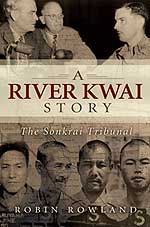A distinguished American citizen named Fred Korematsu died on Wednesday, March 31, in California.
The Japanese made my father a slave.
Yet, after he came to Canada and found out about the internment of Japanese Canadians and Americans, he was appalled.
Korematsu was the man who at 23 who had the courage to challenge the internment of Japanese Americans in a case that went to the U.S. Supreme Court, where he lost.
(For those who have not followed the rest of this blog, my father, along with thousands of others, British, Australian and American prisoners of war was a slave labourer on the Burma Thailand "Railway of Death" best known from the 1956 movie Bridge on the River Kwai. He weighed just 83 pounds when he was released after the war in 1945)
According to AP after the U.S. ordered all Japanese Americans to leave the West Coast but Korematsu refused, saying, "I was really upset because I was branded as an enemy alien when I am an American." He was charged and convicted of espionage and that conviction was upheld by the Supreme Court.
San Francisco Chronicle AP Obituary
It was not until the 1983 that the conviction was overturned.
Here is what I say in part of Book Four of The Sonkrai Tribunal: (In the 1950s my father was the property manager for the Aluminum Company of Canada in Kitimat, British Columbia.)
Time sometimes help to heal and contact helps understanding. My father's job in Kitimat was assistant property manager for Alcan. One of his jobs was to rent shops in the two company owned malls. Early on, a Japanese couple came to my father's office to rent a store. Not knowing my father's history, they casually mentioned during the interview that they had been interned in one of those interior camps. "And we did to them what they did to us," my father told me later, shaking his head. My mother always bought her dresses in their shop. For my father, the roundup in his new country was another example of government betrayal, of grand strategies that cause pain, that bring wounded memories.
In 2004, a Fox news personality and blogger named Michelle Malkin stated that all Japanese were spies during the Second World and that the internment was justified as is racial profiling of Arab Americans.
Korematsu replied in an eloquent column in the San Francisco Chronicle.
Do we really need to relearn the lessons of Japanese American internment?
In the column Korematsu said:
Malkin argues for reviving the old notion of guilt by association....Fears and prejudices directed against minority communities are to easy to evoke and exaggerate, often to serve the political agendas of those who promote such fears.
Now Malkin is celebrating his death in a column that is so horrible that I won't link to it, but those who want to can find it on Technorati.
But she does say
Every high school student knows that most immigrants of German, Italian, and Japanese lineage conspired with their relatives in the "old country" to overthrow the U.S. government.For that I only reply not about the Japanese, but about the internment of Italians, that in the research for my book King of the Mob, I read almost all the declassified files on the internment of Italian Canadians during the Second World. For King, I was using the files to show that the Canadian government was using internment as an attempt to break Italian organized crime. But those files also showed that most of the men who were picked up and interned had no connection with Mussolini.
For many their "crime" was sending money to relatives in the old country. Many others were Italian labourers who worked in the mining or construction industries and handled dynamite. That, according to the police, meant they were "potential saboteurs" and so they were hauled out of their homes and sent to internment camps.
She claims her blog supports "patriotic Americans," reminding me of Samuel Johnson's famous words on April 7, 1775, "Patriotism is the last refuge of the scoundrel."




